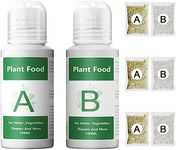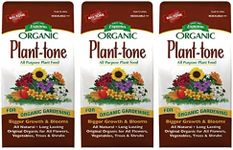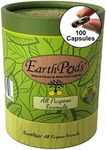Buying Guide for the Best Houseplant Fertilizers
Choosing the right houseplant fertilizer can make a big difference in the health and growth of your indoor plants. Fertilizers provide essential nutrients that might be missing from the soil, especially when plants are grown in pots. The key is to match the fertilizer to your plant’s needs and your own care routine. Understanding the main features of fertilizers will help you make a choice that supports your plants without causing harm.N-P-K RatioThe N-P-K ratio stands for Nitrogen (N), Phosphorus (P), and Potassium (K), which are the three main nutrients plants need. This ratio is usually shown as three numbers on the package, like 10-10-10. Nitrogen helps with leafy growth, phosphorus supports roots and flowers, and potassium aids overall health. If you have leafy plants, a higher nitrogen number is helpful. For flowering or fruiting plants, look for more phosphorus. For general use, a balanced ratio works well. Think about what your plant needs most and choose a fertilizer with a ratio that matches.
Fertilizer Form (Liquid, Granular, Slow-Release, Spikes)Fertilizers come in different forms: liquid, granular, slow-release pellets, and spikes. Liquid fertilizers are mixed with water and are easy to apply during regular watering, making them good for people who like to feed their plants often. Granular and slow-release types are sprinkled on the soil and break down over time, which is convenient if you prefer less frequent feeding. Spikes are pushed into the soil and release nutrients slowly, which is very low-maintenance. Choose a form that fits your care habits and how often you want to fertilize.
Organic vs. SyntheticFertilizers can be organic (made from natural materials) or synthetic (chemically produced). Organic fertilizers are gentler and improve soil health over time, but they may work more slowly. Synthetic fertilizers act quickly and provide precise nutrient amounts, but overuse can harm plants or soil. If you prefer a natural approach and don’t mind slower results, organic is a good choice. If you want fast, predictable results, synthetic might suit you better. Consider your values and how quickly you want to see changes in your plants.
MicronutrientsBesides the main N-P-K nutrients, plants also need small amounts of other nutrients like iron, magnesium, and calcium. Some fertilizers include these micronutrients, which can help prevent certain plant problems. If your plants have yellowing leaves or other unusual symptoms, a fertilizer with added micronutrients can be helpful. For most healthy houseplants, this is less critical, but it’s a nice bonus if you want to cover all bases.
Application FrequencyDifferent fertilizers are designed to be used at different intervals, such as weekly, monthly, or every few months. This is important because over-fertilizing can damage plants, while under-fertilizing can slow their growth. If you like to keep things simple, choose a slow-release or spike fertilizer that only needs occasional application. If you enjoy regular plant care, a liquid fertilizer used every week or two might be more satisfying. Match the frequency to your routine and how much attention you want to give your plants.














